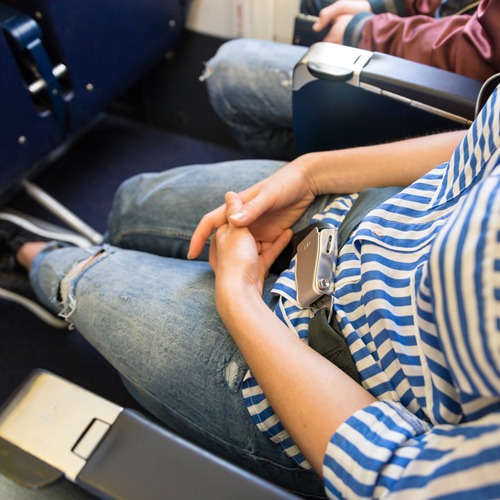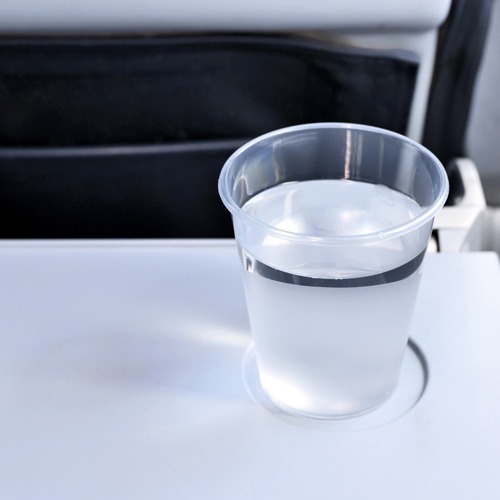Deep vein thrombosis (DVT) occurs when a blood clot forms within one of the body’s major blood vessels, usually somewhere inside the leg. While such a clot is not always dangerous in itself, it can become a major health hazard if it grows larger and migrates to another area of the body. In some cases, DVT can even be fatal if all or part of the clot moves to the lungs and blocks the blood supply there.
If you are planning a long trip, it is important to be aware of the fact that an increased likelihood of DVT is a known risk of long-haul flights. However, there are things you can do before and during your journey in order to minimize your risk. It is in your best interests to take the following twelve suggestions on board.

1) Keep your legs at least somewhat elevated during most of the journey if it is possible, because circulation in your leg veins improves as your legs get closer to being above the level of your heart. If there is space for a footrest, use this to your advantage. Alternatively, even resting your feet on top of your hand luggage under the seat in front of you will elevate your legs to a certain extent. If you are on a quiet flight or traveling during the night, you might also consider lying down on three empty seats so that your legs are level with your head.
2) It is vital that you make a conscious effort to stay hydrated when you are on a plane for longer than four hours, so drink as much water as you can. When you are dehydrated, your blood thickens, and this makes the blood more likely to clot. You will need more water on a plane than you do in normal circumstances, as the air is extremely dry.

3) Investigate the possibility of purchasing compression stockings (i.e. ‘flight socks’) before travel. Their ability to prevent DVT is still contentious, but if you wear them in the correct size then they may be of some benefit to you. However, it is very important that you have flight socks fitted by a pharmacist, nurse or doctor, as it is not always obvious which size to select. There will be no benefit if the socks are too slack, and the socks may actually hinder circulation if they are too tight.
4) Make an appointment with your doctor and discuss whether it would be a good idea for you to take a low dose of aspirin before, during and after your flight. Current research on aspirin’s efficacy at preventing blood clots yields mixed results, but your doctor will give you advice on this topic (taking the rest of your medical profile into account).
5) Do your best to avoid letting the edge of your seat press tightly against your thighs, as sitting with anything pressed against your legs slows the circulation.
6) Walk up and down the aisles of the plane as often as is realistic. In general, it is the long periods of inactivity and lack of movement that link long-haul flights with an increased risk of DVT, as this behavior leads to slow and sluggish circulation (which in turn leads to a higher likelihood of clotting). Picking an aisle seat on the plane will make it easier for you to get up and walk around on a regular basis.
7) Every now and again, rhythmically clench and relax your leg muscles ten to twenty times. This is an exercise that increases leg circulation but does not require you to stand up.
8) At similar intervals to the exercise described above, lift your knees off the ground and bring them up towards your chest. This is another effective exercise that can be done while you are still seated.
9) Another exercise that you can do to improve your circulation while in your seat involves alternately pointing your toe and then your heel towards the floor in quick and strong movements.
10) Do not sit with your legs crossed (as this creates pressure on the veins of the legs and slows circulation).
11) Avoid alcohol before and during your flight, as alcoholic drinks will also dehydrate you more than normal given the dry atmosphere of the plane.
12) When you get up to walk around or go to the restroom, try to do more vigorous leg exercises. You can do these at the back of the plane, or in the restroom itself if you feel uncomfortable doing leg exercises in front of other people. All of the seated exercises described above are useful if done while standing. In addition, you might try taking ten to twenty ‘marching’ steps (raising your knees high), or rocking back and forth from your heels to the balls of your feet.
Final Thoughts
If you follow all the above advice, you will be substantially reducing your risk of developing an unwanted blood clot during your flight. If you do experience leg pain during or after a flight, see your doctor as soon as possible. You may just have sprained a tendon or sustained a similar injury, but since DVT can be deadly it is always better to be safe than sorry.
